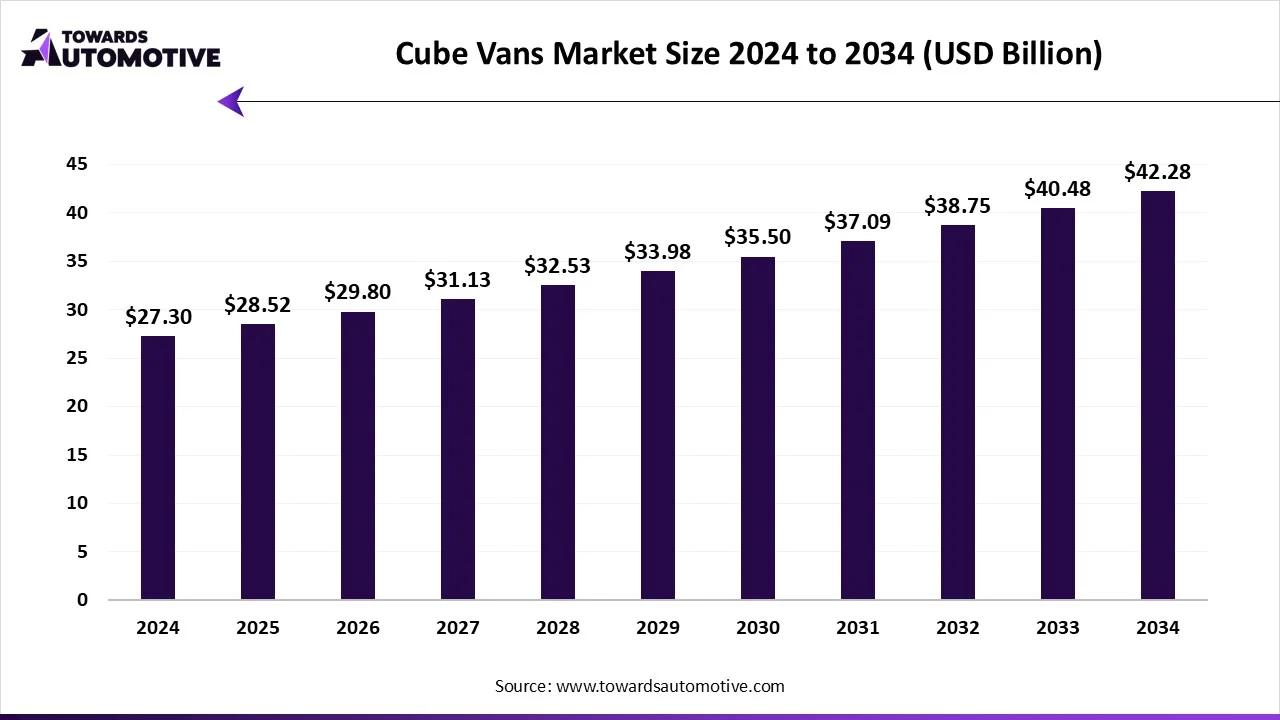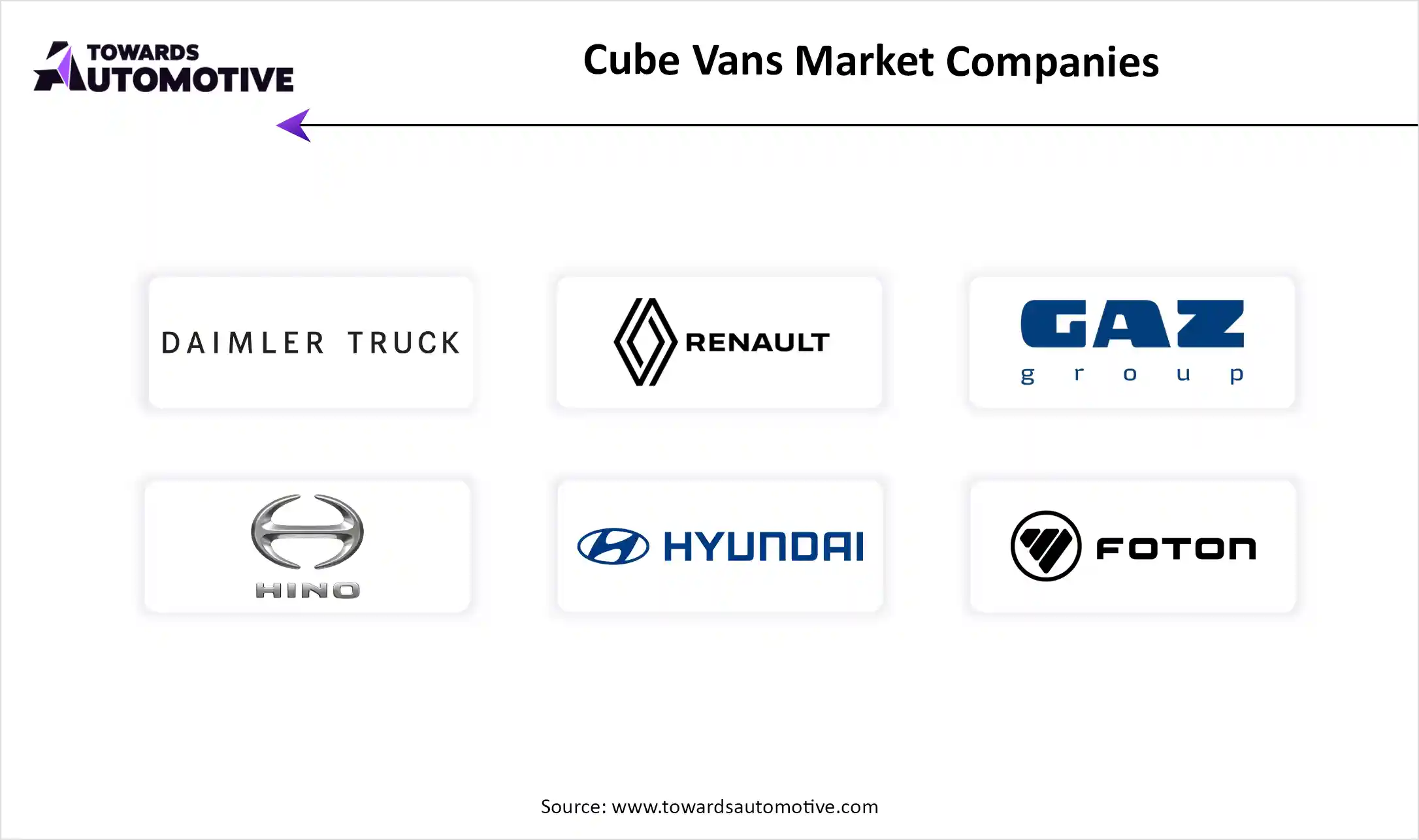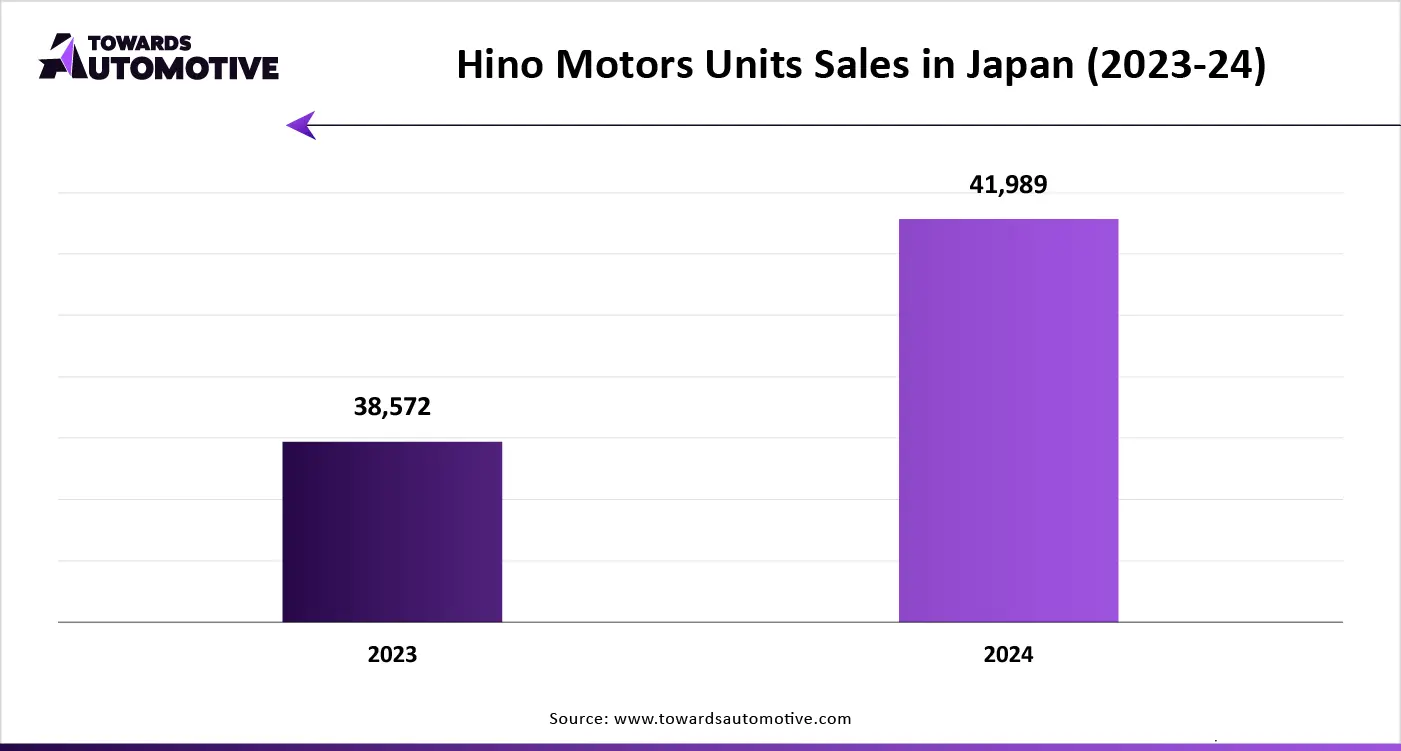August 2025
The cube vans market is projected to reach USD 42.28 billion by 2034, growing from USD 28.52 billion in 2025, at a CAGR of 4.48% during the forecast period from 2025 to 2034. The growing adoption of cube vans by small organizations coupled with integration of advanced technologies such as AI and IoT in modern vans has driven the market expansion.
Additionally, the rising popularity of last-mile delivery services along with numerous government initiatives aimed at reducing vehicular emission is contributing to the industrial growth. The increasing sales of plug-in hybrid vans as well as technological advancements in solid-state batteries is expected to create ample growth opportunities for the market players in the upcoming days.

The cube vans market is a prominent sector of the automotive industry. This industry deals in manufacturing and distribution of box trucks around the world. There are numerous types of vans manufactured in this sector comprising of compact cube vans, medium cube vans, large cube vans and some others. These vans are powered using different propulsion technologies including gasoline-powered, diesel-powered, electric-powered, hybrid and others. It finds application in various sectors consisting of logistics and transportation, delivery services, construction and maintenance, healthcare, retail and some others. The growing demand for cube vans from the e-commerce sector is contributing to the market expansion. This market is expected to rise significantly with the growth of the EV sector in different parts of the globe.
| Metric | Details |
| Market Size in 2024 | USD 27.3 Billion |
| Projected Market Size in 2034 | USD 42.28 Billion |
| CAGR (2025 - 2034) | 4.48% |
| Leading Region | North America |
| Market Segmentation | By Vehicle Size, By Application, By Powertrain, By Customization and By Region |
| Top Key Players | Daimler Truck, Renault, Peugeot, GAZ Group, Hino Motors, Hyundai, Iveco |
The major trends in this market consists of popularity of online shopping, partnerships and AI-based fleet management platforms.
The popularity of online shopping has gained traction in developed nations such as the U.S., Germany, China and some others has increased the demand for cube vans.
Several automotive brands are partnering with each other to develop high-quality cube vans to cater the needs of the end-users.
The fleet operators are integrating AI-based fleet management platforms to optimize and track cube vans.
The large cube vans segment dominated the market. The growing demand for large-sized cube vans from the logistics and transportation sector has driven the market expansion. Additionally, the rising application of these vans in the e-commerce industry along with rapid investment by market players for developing large-sized cube vans to cater the requirements of several end-users is contributing to the industrial growth. Moreover, the increasing sales of large-sized electric cube vans in different parts of the world is expected to drive the growth of the cube vans market.
The medium cube vans segment is expected to expand with a significant CAGR during the forecast period. The growing demand for medium-sized cube vans from the retail sector to transport goods from warehouses to local shops has boosted the market growth. Also, the rapid adoption of hybrid cube vans in the construction industry for transporting building materials is playing a vital role in shaping the industrial landscape. Moreover, the increasing application of these vans for enhancing last-mile delivery services is expected to propel the growth of the cube vans market.
The logistics and transportation segment held the largest share of the market. The growing demand for cube vans in the logistics sector for transporting goods in short distances has boosted the market growth. Additionally, numerous government initiatives aimed at rising awareness related to green logistics coupled with rise in number of local logistics operators in several countries such as the U.S., India, France and some others is adding to the industrial expansion. Moreover, the rising adoption of electric vans in the logistics sector for reducing vehicular emission is expected to drive the growth of the cube vans market.
The healthcare segment is expected to grow with a considerable CAGR during the forecast period. The increasing use of box trucks from the healthcare sector for transporting medicines from one city to another has driven the market expansion. Also, rapid investment by government for developing the healthcare sector coupled with rise in number of medicine distributors in different parts of the world is playing a crucial role in shaping industrial landscape. Moreover, the growing use of refrigerated trucks from the healthcare sector for transporting vaccines and other essential medical items is expected to propel the growth of the cube vans market.
The gasoline-powered segment led the market. The growing use of petrol-powered vans in the logistics sector for transporting goods in short distances has boosted the market expansion. Additionally, the absence of well-established EV charging networks in several countries such as Poland, Hungary, Mexico and some others is contributing to the industrial growth. Moreover, partnerships among logistics companies and automotive brands for deploying high-quality petrol box trucks is expected to drive the growth of the cube vans market.
The electric-powered segment is expected to grow with the highest CAGR during the forecast period. The growing adoption of electric-powered box trucks in the construction sector has driven the market growth. Additionally, numerous government initiatives aimed at developing the EV charging infrastructure coupled with technological advancements in the electric vehicle industry is playing a vital role in shaping the industrial landscape. Moreover, rapid investment by startup companies for developing affordable eco-friendly cube vans is expected to boost the growth of the cube vans market.
North America held the highest share of the cube vans market. The growing sales of electric cube vans in the U.S. and Canada has boosted the market expansion. Additionally, rising investment by automotive brands for developing advanced cube vans coupled with rapid expansion of the logistics sector is playing a vital role in shaping the industrial landscape. Moreover, the presence of several market players such as Ford Motor Company, General Motors Company, RAM Trucks and some others is expected to boost the growth of the cube vans market in this region.
U.S. dominated the market in this region. The rising demand for cube vans from the construction sector coupled with rapid adoption of green logistics has driven the market growth. Additionally, the integration of advanced telematics by fleet operators as well as rapid development in the automotive sector is playing a vital role in shaping the industry in a positive direction.
Asia Pacific is expected to rise with a significant CAGR during the forecast period. The rising demand for large-sized cube vans from the retail sector in several countries such as China, India, South Korea and Japan has driven the market growth. Additionally, the rapid adoption of cube vans from the healthcare sector as well as growing adoption of eco-friendly vans in the construction industry is playing a crucial role in shaping the industrial landscape. Moreover, the presence of numerous cube van companies such as Hyundai Motor Company, Toyota Motor Corporation, ISUZU and some others is expected to propel the growth of the cube vans market in this region.
China held the largest share of the market in this region. In China, the market is generally driven by the rapid growth of the e-commerce sector along with rapid shift towards electric cube vans. Moreover, the rise in number of EV startups coupled with rapid expansion of the last-mile delivery services is crucial for the industrial growth.

The cube vans market is a highly competitive industry with the presence of several dominating players. Some of the prominent companies in this industry consists of Daimler Truck, Renault, Peugeot, GAZ Group, Hino Motors, Hyundai, Iveco, Toyota, Dongfeng, Foton, Fiat, and some others. These companies are constantly engaged in manufacturing cube vans and adopting numerous strategies such as partnerships, joint ventures, collaborations, acquisitions, launches, and some others to maintain their dominance in this industry.

By Vehicle Size
By Application
By Powertrain
By Customization
By Region
August 2025
August 2025
June 2025
June 2025
We offer automotive expertise for market projections and customizable research, adaptable to diverse strategic approaches.
Contact Us